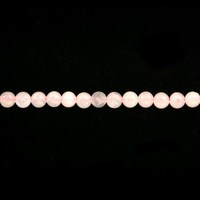Beader’s dictionary
C
CAMEO
A cameo is a low-relief glyptic art carving technique (art of stone carving in relief or intaglio). This technique is used on materials made of layers of colors. The sculptor must carve while taking into account the different layers of color and depth to play with so that the various colors are positioned in the right places. Cameos representations are often found as a bust of an influential political, cultural or religious character. Hence, the term "cameo" also refers to the resulting object of the carving.
The most popular stratified materials that are used are onyx, banded agate, sardonyx, carnelian-onyx, chalcedony, the shell from layered seashells and glass. Sometimes, the color differences are exacerbated by dye. White strata, as they are very compact, do not stain, unlike the softer strata.
Stone cameos are very expensive, thus they were replicated in materials such as shells, glass, coral or lava. Today, we also find imitations made of various other materials.
A little bit of history: The cameo was very fashionable in Classical Antiquity then forgotten and resurfaced during Renaissance as Napoleon was an avid cameo collector and he instituted a special school to promote the engraving of stones.
CHALCEDONY (See products)
The term chalcedony designates all varieties of quartz and microcrystalline and cryptocrystalline. It includes agate, carnelian, jasper, onyx and other varieties of quartz. However, the term chalcedony is often used to denote the common chalcedony sensu stricto. It can have a milky appearance and be transparent, and bluish white-grey.
It can be dyed as it is porous. It can be found in Brazil, the United States, India, Madagascar, Namibia, Sri Lanka and Zimbabwe.
A little bit of history: The name comes from the Greek "Karchêdôn", an ancient transit city on the Bosphorus (Istanbul strait). Roman and Egyptian used it in cameos, seals and amulets. Today, it is often found in the form of a cabochon, as beads, rings or artifacts. In the Neolithic period, chalcedony was used to make tools.
G
GURU BEAD (See products)
Guru beads are rounds beads that have three holes when they are looked at from the outside. If we could see through the bead, the bead’s hole would be shaped like a “T”. These beads are always paired with a second conically shaped bead. They are used to join string ends. Both string extremities are threaded in the holes above the “T” and are exited together in the hole bellow the “T”. Following which, the conic bead is strung and the strings are tied together. Their size vary, however they more often than not measure about 8mm. They are generally made with semiprecious stones such as agates, cornelian and onyx but can also be made of wood and glass. The guru beads are often used to finish bracelets or mala bead necklaces (Buddhist or Hindu rosaries). This part of the rosary would represent Buddha or the master, thus the name guru.
O
ONYX (See products)
Onyx is a ribboned gemstone of the Quartz family and of the chalcedony variety. It has colored layers. Real Onyx has a base layer that is black, overlapped with a white layer. The term onyx can also be used to identify a monochromatic chalcedony (like black onyx) not to be confused with marble-onyx (calcareous onyx) that is often referred to as black onyx.
Onyx is often used to make cameos because it allows for the cutting of a pale layer over a darker one. Onyx is often found in cabochons but may be facetted as well. It can also be found as a reconstituted stone.
Q
QUARTZ
The term "quartz" refers to a family of minerals within the group of silicates. Quartz composes 12% of the lithosphere (outermost shell) and is the most common mineral. Quartzs are divided into different categories, among them the macrocrystalline quartz (amethyst, citrine, rock crystal, quartz smoke, rose quartz, blue quartz, quartz cat-eye, iron-eye, falcon-eye and tiger-eye ) and microcrystalline quartz (chalcedony, carnelian, onyx, agate, chrysoprase, jasper and petrified wood).
Z
ZODIAC STONES
During Antiquity as well as Middle-Ages, it was believed that the formation of gems was influenced by constellations, some gems were as bright as stars. They were thought to be the mirrors of the cosmos. Therefore each planet was associated with one or more gems that possess “magical” properties. These beliefs still circulate in todays modern society, even though there are no tangible proof to support them.
| Sign | Stones |
|---|---|
| ARIES | Carnelian, red jasper |
| TAURUS | Carnelian, pink quartz |
| GEMINI | Citrine, tiger's eye |
| CANCER | Chrysoprase, aventurine |
| LEO | Rock crystal, golden quartz |
| VIRGO | Citrine, yellow agate |
| LIBRA | Orange citrine, smoked quartz |
| SCORPIO | Blood red Carnelian |
| SAGITTARIUS | Sapphire, chalcedony |
| CAPRICORN | Onyx, rutilated quartz |
| AQUARIUS | Turquoise, falcon eye |
| PISCES | Amethyst, quartz amethyst |













